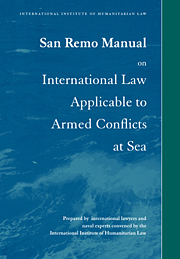 San Remo Manual on International Law Applicable to Armed Conflicts at Sea
San Remo Manual on International Law Applicable to Armed Conflicts at Sea Book contents
- Frontmatter
- Contents
- FOREWORD
- SAN REMO MANUAL
- EXPLANATION
- Introduction
- List of abbreviations
- Part I General provisions
- Part II Regions of operations
- Part III Basic rules and target discrimination
- Part IV Methods and means of warfare at sea
- Part V Measures short of attack: interception, visit, search, diversion and capture
- Part VI Protected persons, medical transports and medical aircraft
- INDEX
Part III - Basic rules and target discrimination
Published online by Cambridge University Press: 04 August 2010
- Frontmatter
- Contents
- FOREWORD
- SAN REMO MANUAL
- EXPLANATION
- Introduction
- List of abbreviations
- Part I General provisions
- Part II Regions of operations
- Part III Basic rules and target discrimination
- Part IV Methods and means of warfare at sea
- Part V Measures short of attack: interception, visit, search, diversion and capture
- Part VI Protected persons, medical transports and medical aircraft
- INDEX
Summary
Section I Basic rules
38 In any armed conflict the right of the parties to the conflict to choose methods or means of warfare is not unlimited.
38.1 There are no explicit treaty provisions at the present time which specifically state that the general principles applicable in armed conflict on land are also relevant to the conduct of hostilities at sea. However, it logically follows from the whole body of law that this general principle is firmly rooted in the law of naval armed conflict. Moreover, on 19 December 1968, the United Nations General Assembly, in Resolution 2444 (XXIII), unanimously affirmed certain principles underlying the law of armed conflict, including the requirements stated in paragraphs 38 and 39.
38.2 This basic rule obviously finds its roots in conferences and discussions which took place in the nineteenth century. The principle found its way into documents on the law of armed conflict as early as 1874 at the Brussels Conference (Article 12). The formulation was subsequently developed in the Hague Regulations of 1907 (Article 22). With regard to the wording of the paragraph, it should be noted that it is taken from Article 35(1) of Additional Protocol I. Although that Article falls outside the scope of Article 49(3), of the Protocol and therefore already applies in naval warfare, it was felt appropriate to include it in this document to emphasise the importance of the principle. Additional comments on the rule can therefore be found in existing commentaries. Relevant to the effective implementation of this paragraph is also Article 36 of API regarding new weapons.
- Type
- Chapter
- Information
- San Remo Manual on International Law Applicable to Armed Conflicts at SeaInternational Institute of Humanitarian Law, pp. 113 - 166Publisher: Cambridge University PressPrint publication year: 1995


